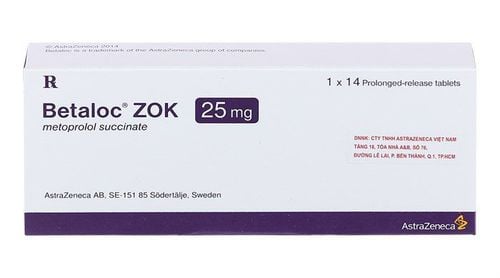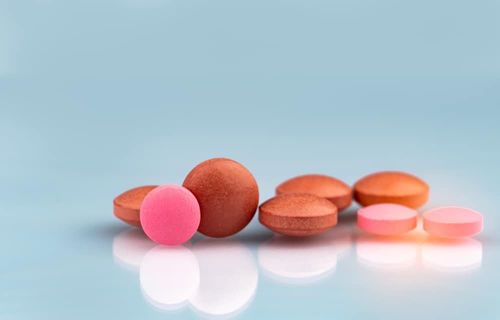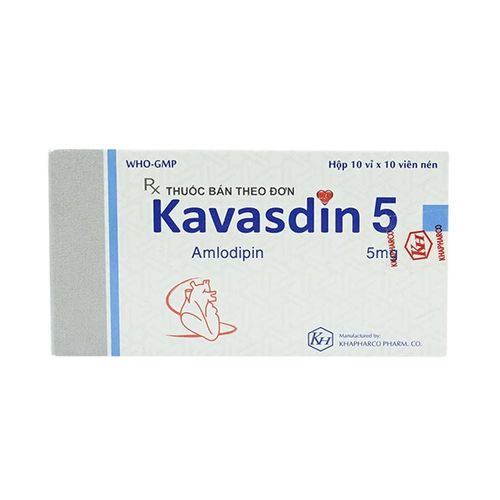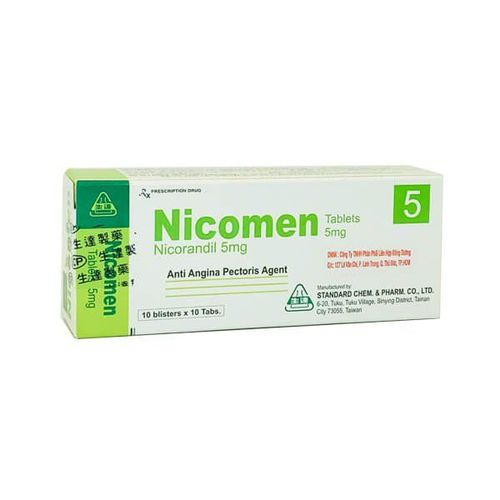This is an automatically translated article.
Pecrandil is indicated for the treatment of chronic stable angina pectoris. To ensure the effectiveness of treatment and avoid side effects, users need to strictly follow the instructions of the doctor, professional pharmacist.
1. What is Pecrandil 5?
Pecrandil 5 is made in the form of tablets, with ingredients including Nicorandil 5mg and excipients such as Microcrystalline cellulose, lactose, sodium starch glycolate, crospovidone, magnesium stearate, b6t talc, colloidal silicon dioxide, just enough for 1 tablet.
Uses Pecrandil 5 is known to prevent long-term treatment of chronic stable angina. With the ingredient Nicorandil is a Nicotinamide ester that helps vasodilate, antispasmodic, reverse coronary spasm, does not have a direct effect on the patient's myocardial contractility.
2. Contraindications of Pecrandil 5
The following cases are recommended contraindication to the use of Pecrandil 5:
People with hypersensitivity to nicorandil or any of its components Persons in shock (including cardiogenic shock), severe hypotension, or confusion left ventricular function with low thickening pressure or cardiac decompensation. Patients who are taking 5-phosphodiesterase inhibitors are at risk of severe hypotension. People use soluble guanylate cyclase stimulants such as riociguat, as this can lead to a serious drop in blood pressure. The patient is at risk of volume depletion. Patients with acute pulmonary edema.
3. Dosage and how to use Pecrandil 5
Pecrandil 5 is taken orally, can be used during and after meals, twice a day, morning and night, or depends on the specific prescription of the treating doctor for each patient.
The following dosage of Pecrandil 5 can be used as reference for common patients:
For adults:
The initial dose is to use 2 tablets x 2 times/day or 1 tablet x 2 times/day for easy-to-use patients. headache. Then gradually increase the dose according to the patient's response. The usual dose is 2-4 tablets x 2 times/day. The doctor can increase to 8 tablets x 2 times / day if needed, depending on the patient's condition. For adults with hepatic and renal impairment, no dose adjustment is required.
4. The drug is not recommended for use in children.
Patients with acute overdose, the body will have symptoms such as peripheral vasodilation, decrease in blood pressure, tachycardia. At this time, the patient should immediately go to a medical facility to monitor heart function and combine other supportive measures in a timely manner. If necessary, the patient can be increased plasma volume with appropriate fluids. If there is a life-threatening risk, the use of vasopressors may be considered for management.
5. Pecrandil 5 . side effects
Headache is a very common symptom of Pecrandil side effects. 5. Some other common symptoms are:
Increased heart rate if high dose is used. Vomiting, nausea, rectal bleeding. Dizziness, vasodilation causing flushing. Weakness, fatigue. Less common side effects but also to watch out for are:
Decreased blood pressure. Mouth ulcers, angioedema, muscle aches. Rare:
Rash, pruritus. Gastritis, ulcers of the mouth, tongue, intestinal tract, anal ulcers , hyperkalemia. Muscle pain, abdominal pain. A very small number of patients have side effects such as edema, fluid retention, or conjunctivitis, conjunctival ulcers, corneal ulcers, skin and mucosal ulcers (mainly ulcers around the anus and genitals). ).
Patients can not be subjective with the side effects of Pecrandil 5. Therefore, it is necessary to notify the doctor immediately for advice on the above symptoms.
6. Adverse drug interactions of Pecrandil 5
Some interactions of Pecrandil 5 that patients need to know as well as treating doctors must be aware of, are:
5-Phosphodiesterase inhibitors (Sildenafil, Vardenafil), soluble Guanylate cyclase inducers severe hypotension, the combination is contraindicated. Concomitant use of Pecrandil 5 with antihypertensive drugs increases the antihypertensive effect. Dapoxetine can lower orthostatic blood pressure. Corticosteroids can be the cause of gastrointestinal perforation, patients should be very cautious when used concurrently. Concomitant use of Pecrandil 5 with NSAIDs, acetylsalicylic acid at both preventive and anti-inflammatory doses, increases the risk of serious gastrointestinal complications such as ulceration, perforation, gastrointestinal bleeding. Use with caution with drugs that can increase blood potassium. Thus, patients should be honest with the doctor treating the drugs they are using so that the doctor can understand and consider prescribing combination drugs, minimizing the possible harmful interactions for the body.
7. Precautions when using Pecrandil 5
People who are breastfeeding, pregnant are advised not to use Pecrandil 5. Ulcers, gastrointestinal bleeding, eye ulcers may occur in patients treated with Nicorandil. Therefore, patients need to be cautious, stop using Nicorandil and inform their doctor before using Pecrandil 5. Patients with diverticulitis may be at risk of fistula formation, even bowel perforation. In addition, patients with heart failure grade III, G6PD enzyme deficiency should be cautious when using Nicorandil. Thus, when using Pecrandil 5 for treatment, patients need to be very attentive and careful with interactions with other drugs to achieve the best treatment effect.
Pecrandil is indicated for the treatment of chronic stable angina pectoris. To ensure the effectiveness of treatment and avoid side effects, users need to strictly follow the instructions of the doctor, professional pharmacist.
Follow Vinmec International General Hospital website to get more health, nutrition and beauty information to protect the health of yourself and your loved ones in your family.
Please dial HOTLINE for more information or register for an appointment HERE. Download MyVinmec app to make appointments faster and to manage your bookings easily.













